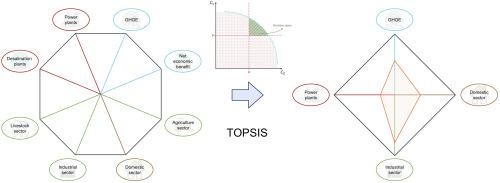通过降维和多参与者决策策略平衡水-能源-食物关系中的利益相关者目标
IF 3.9
2区 工程技术
Q2 COMPUTER SCIENCE, INTERDISCIPLINARY APPLICATIONS
引用次数: 0
摘要
水、能源和粮食是满足人类基本需求、确保经济发展和实现可持续发展目标所需的关键资源。然而,人口快速增长和气候变化的影响导致对这些资源的需求增加。此外,水、能源和食物是高度相关的,在它们的供应链上既有协同作用,也有权衡取舍。这些资源之间的联系及其相互依赖性的研究在文献中被称为水-能源-食物关系(WEFN)。世界经济论坛系统的一个关键方面是,它们是由具有相互竞争的目标和关切的多个行动者综合起来的。当使用优化工具解决WEFN系统时,利益相关者利益的结合增加了问题的维度。在本研究中,我们提出了一种基于后最优分析的降维方法,通过对特定行为者的经济目标施加非负性约束。从降维新问题出发,采用TOPSIS多准则决策分析(MCDA)方法,选取不同情景下WEFN系统配置的折衷解,并对所分析的准则进行不同重要性的权衡。通过将MCDA工具与降维策略相结合,该方法允许分析更少的系统配置,从而在减少决策空间时达到折衷,而不会丢失信息。本研究强调,未来的研究必须采用参与性的方法,考虑社会的意见和关切,从而确保公众在资源分配和整个世界经济论坛系统管理方面的接受。本文章由计算机程序翻译,如有差异,请以英文原文为准。

Balancing stakeholder objectives in the water-energy-food nexus through dimension reduction and multi-actor decision strategies
Water, energy, and food are critical resources required to meet basic human needs, ensure economic development, and achieve sustainable development goals. However, the effects of rapid population growth and climate change have resulted in increased demand for these resources. Furthermore, water, energy, and food are highly interrelated, presenting both synergisms and trade-offs along their supply chains. The connection of these resources and the study of their interdependencies have been addressed in the literature as the Water Energy Food Nexus (WEFN). A critical aspect of WEFN systems is that they are integrated by multiple actors with competing goals and concerns. When addressing WEFN systems with optimisation tools, the incorporation of stakeholders’ interests increases the dimensions of the problem. In this study, we propose a dimensionality reduction approach based on a post-optimal analysis by imposing non-negativity constraints on specific actors’ economic goals. From the new problem with reduced dimensions, the TOPSIS multi-criteria decision analysis (MCDA) method was employed to select compromise solutions for the configuration of the WEFN system under different scenarios with varying importance for the analysed criteria. By coupling MCDA tools with dimensionality reduction strategies, this approach allows the analysis of fewer system configurations for reaching compromise without losing information when reducing the decision space. The study highlights the necessity for future research to adopt participatory approaches and consider societal opinions and concerns, thereby ensuring public acceptance in resource allocation and overall WEFN system management.
求助全文
通过发布文献求助,成功后即可免费获取论文全文。
去求助
来源期刊

Computers & Chemical Engineering
工程技术-工程:化工
CiteScore
8.70
自引率
14.00%
发文量
374
审稿时长
70 days
期刊介绍:
Computers & Chemical Engineering is primarily a journal of record for new developments in the application of computing and systems technology to chemical engineering problems.
 求助内容:
求助内容: 应助结果提醒方式:
应助结果提醒方式:


